Banner campaign
Latest
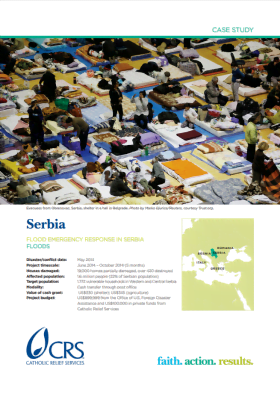
Using Cash for Shelter: Flood Emergency Response in Serbia
Case Study
The devastating floods that affected the Balkans in May 2014 affected 1.6 million people, 22 percent of Serbia’s population, and have set the country’s economic development back decades. Catholic Relief Services (CRS) conducted rapid assessments in 13 villages in the municipalities of Šabac, Valjevo,...
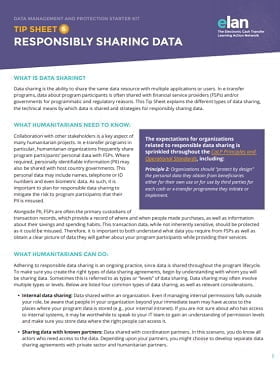
Data management and protection starter kit: Tip sheet 6: Responsibly Sharing Data
Guidelines and Tools
Data sharing is the ability to share the same data resource with multiple applications or users. In e-transfer programs, data about program participants is often shared with financial service providers (FSPs) and/or
governments for programmatic and regulatory reasons. This Tip Sheet explains the different...

Development of Training Modules on the Fundamental Concepts of Cash and Voucher Programming
Guidelines and Tools
The CALP Network is in its first year of a 5 year strategy. The first year has been marked by opening up the CALP Network’s membership to its wider community of practice, with a significant growth in membership expected in 2016,
the development of a Board of Directors, made up of up to 13...

Intra-Household Dynamics and the Design of Social Protection Programs: The Case of Polygamous Households in North Burkina Faso
Case Study
A recent overview of World Bank social safety net programs and gender highlighted the need for greater consideration of intra-household dynamics in the design of social protection programs (Bardasi 2014). During program design, decisions have to be made about who to target, how much and how often to give...

ELAN Workshop Report: E-Transfers in Iraq and Syria
Report
This report outlines the main conclusions and takeways of ELAN workshop held in Iraq. The event was organized to meet the following objectives: Introduce participants to the what, why, and when of e-transfers. Explore solutions to the particular challenges of using e-transfers in Iraq and Syria. Share...
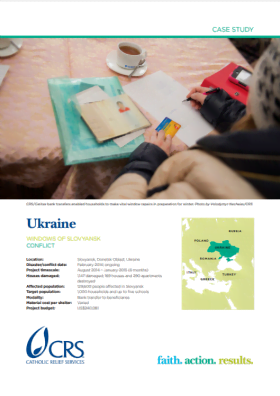
Using Cash for Shelter: Windows of Slovyansk
Case Study
After pro-Russian separatists declared republics in Eastern Ukraine in April 2014, Slovyansk became a focal point of fighting between government forces and rebels until the Ukrainian military retook the city in early July. Slovyansk saw the heaviest fighting of any urban area and many city dwellers fled....
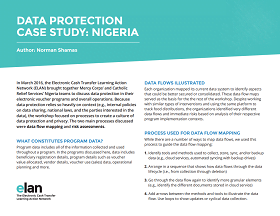
Data Protection Case Study: Nigeria
Report
In March 2016, the Electronic Cash Transfer Learning Action Network (ELAN) brought together Mercy Corps’ and Catholic Relief Services’ Nigeria teams to discuss data protection in their electronic voucher programs and overall operations. Because data protection relies so heaviliy on context (e.g.,...
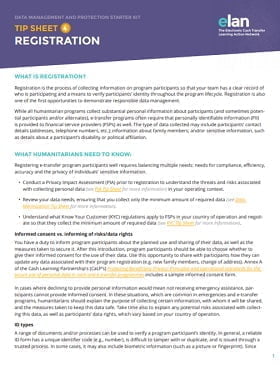
Data management and protection starter kit: Tip sheet 4: Registration
Guidelines and Tools
Registration is the process of collecting information on program participants so that your team has a clear record of who is participating and a means to verify participants’ identity throughout the program lifecycle. Registration is also one of the first opportunities to demonstrate responsible data...

Revised Pre-Crisis Market Analysis (PCMA)
Guidelines and Tools
The purpose of this guidance is to provide field practitioners, across the different sectors, with a practical step-by-step process of how to plan, carry out, and update pre-crisis market mapping and analysis, leading to response/programme design and implementation as well as surveillance, early...

What to know: working with humanitarians on e-cash programs
Report
International humanitarian assistance rose to a record US$24.5 billion in 2014. The 2015 Global Humanitarian Assistance Report indicated that over US$200 million of this was used in cash and voucher programs. An increasing number of humanitarian actors have begun to deliver cash electronically, through...

ELAN Vocabulary and Usage
Guidelines and Tools
As e-transfer programs, technologies and products develop, key terms, phrases and working definitions are evolving alongside them. At the moment, these words and phrases are rarely standardized, and often hold unique meanings within different contexts and to different stakeholders. In order to facilitate...
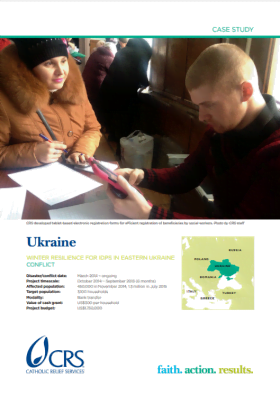
Using Cash for Shelter: Winter Resilience for IDPs in Eastern Ukraine
Case Study
Continued conflict in Eastern Ukraine during 2014 caused internal displacement of over 1.46 million people by September 2015, and another 1,123,800 fled to other countries, according to the United Nations High Commissioner for Refugees. Rapid assessments carried out by Catholic Relief Services found that...
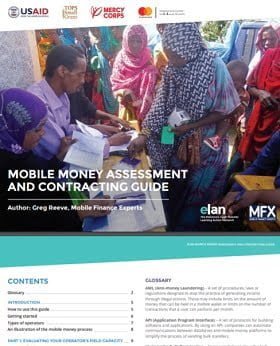
Mobile money assessment and contracting guide
Guidelines and Tools
Mobile money offers tremendous potential to enable cash transfers at scale and connect program participants to financial services. Oftentimes, however, humanitarian practitioners struggle to understand mobile money terminology to confidently evaluate different mobile money operators and to design...

Data management and protection starter kit: Tip sheet 2: Data minimization
Guidelines and Tools
Data minimization is a privacy principle that requires the people collecting data to be intentional about what type of data is collected and how long it is retained. To meet this principle, teams should limit data collection to what is directly relevant and necessary to accomplish a specified purpose. In...

When the Money Runs Out Do Cash Transfers Have Sustained Effects on Human Capital Accumulation
Report
This study examines the medium-term effects of a two year cash transfer program targeted to adolescent girls and young women. Significant declines in HIV prevalence, teen pregnancy, and early marriage among recipients of unconditional cash transfers (UCTs) during the program evaporated quickly two...

Partnering with FSPs to Deliver Cash in Nepal: Top Considerations
Guidelines and Tools
Cash transfers are a proven way to help disaster-affected communities flexibly meet urgent basic needs. Several humanitarian agencies are planning cash transfers to support tens of thousands of Nepali earthquake survivors. While initial responses will likely rely on direct cash in envelopes, cash...

Using Cash for Shelter: Rent Assistance for Syrian Refugees
Case Study
Over 600,000 Syrian refugees have arrived in Jordan since 2011; 80 percent of these live in urban or peri-urban locations rather than in camp settings. Families in this situation must pay rent for their shelter, and are therefore subject to shifts in rental market values. Rents have inflated substantially...
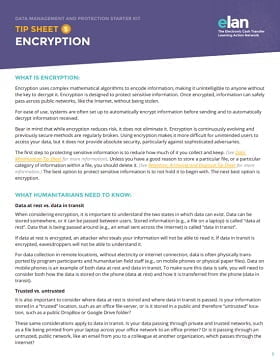
Data management and protection starter kit: Tip sheet 5: Encryption
Guidelines and Tools

Prepaid Card Products For Humanitarian Programs: Actors, Insights & Recommendations
Guidelines and Tools
Today, over 130 million people need humanitarian support to survive. Fortunately, new tools such as prepaid cards allow us to respond to these needs with increasing flexibility and efficiency. Today’s leading humanitarian agencies are increasing their use of prepaid cards in places like Jordan, the...
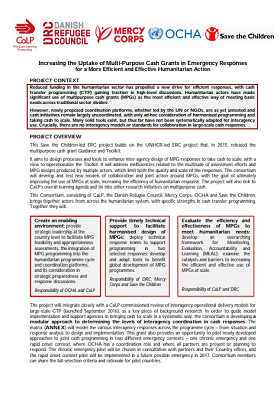
Increasing the Uptake of Multi-Purpose Cash Grants in Emergency Responses for a More Efficient and Effective Humanitarian Action
Report
Reduced funding in the humanitarian sector has propelled a new drive for efficient responses, with cash transfer programming (CTP) gaining traction in high-level discussions. Humanitarian actors have made significant use of multipurpose cash grants (MPGs) as the most efficient and effective way of meeting...